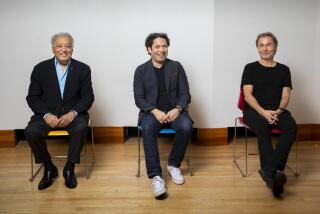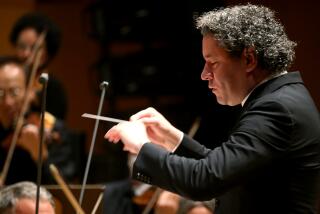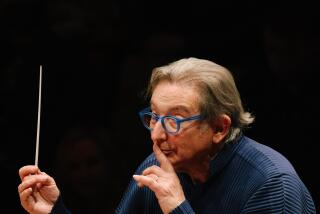Experimental composer worked on grand scale
- Share via
Henry Brant -- an American maverick composer who added the dimension of space to music by placing musicians in nooks and crannies of concert halls, on boats floating down the Amstel River in Amsterdam or arrayed throughout sports arenas -- has died. He was 94.
The Pulitzer Prize-winning composer died Saturday at his home in Santa Barbara, according to associates.
Brant’s pieces were always events tailor-made for specific sites. A typical example was “500: Hidden Hemisphere,” commissioned in 1992 by Lincoln Center in New York in honor of the 500th anniversary of Columbus’ voyage to the New World. Brant positioned military and civilian marching bands as well as a steel-drum band around the campus’ reflecting pool. The composer, a small man never seen without a baseball cap or visor, was dressed in his usual color-coordinated athletic garb, this time blinding yellow.
Much of the music of America’s past, its dances and marches and dirges, was played simultaneously. But Brant’s ingenious use of the location and carefully engineered counterpoint allowed the ear to accommodate the various musical strands. Music not meant to get along did.
Brant often thought big. In 1984, he turned central Amsterdam into a concert venue with “Fire on the Amstel.” He needed four boats to carry 100 flutists for a piece that also incorporated multiples of jazz drummers, church carillons, brass bands and street organs. “Orbits,” a 1979 work for 80 trombones, at one point has an 80-note chord, half the pitches part of the standard 12-note scale, the other half microtones (pitches that would fall between the cracks of a piano keyboard).
In “Ice Field,” for which he was awarded the Pulitzer in 2002, he placed sections of the San Francisco Symphony all over Davies Symphony Hall. The full brass section became a jazz big band. Woodwinds squealed as high as they could from the balconies. Facing the audience were gongs, bass drums and steel drums. The oboes and bassoons buzzed in the choir loft. Brant, in concert dress but nevertheless sporting a poker player’s visor, improvised on the hall’s large pipe organ.
All of this gave him the reputation of a kook, even with the Pulitzer. The prize came late in his career. At 88, he was the oldest composer to have won it. But he said in an interview that the most it did for him was to persuade a few more presenters to say, “Well, let’s look at this minor screwball music.”
Nonetheless, Brant was a major figure in American music. He was a noted educator and orchestrator with a varied career that included jazz, conducting and film work. Beginning with “Antiphony 1” in 1953, he was a pioneer of spatial music, and from then on he wrote more than 100 works in which the layout of the performers determined the nature of the music. All music is spatial, he said, because all music must emanate from somewhere. But he was the first composer to devote a career to exploring the expressivity of space.
Henry Brant was born Sept. 15, 1913, in Montreal to American parents. His father was a violinist who had studied with Joseph Joachim.
Brant had an early musical education and was naturally drawn to the offbeat, designing instruments out of plumbing pipes and cigar boxes.
At the suggestion of Henry Cowell -- the experimental West Coast composer who was the first to play the strings inside the piano -- Brant’s father moved the family to New York in 1929 to widen his son’s musical education.
Brant attended the Juilliard School and studied privately with Aaron Copland and George Antheil.
In New York, Brant led a double, and sometimes triple, musical life. He wrote the furthest-out music he could come up with -- contrapuntally complex, wildly dissonant and unconventional in form -- but he also became more deeply involved in jazz and popular music and found work during the Depression and World War II conducting on radio and orchestrating for films. Virgil Thomson brought him in to orchestrate his scores for the Pare Lorentz documentaries “The Plow That Broke the Plains” and “The River.”
After the war, Brant taught at Juilliard, Columbia University and Bennington College in Vermont. He continued film work on the side and orchestrated several notable Alex North scores, such as those for John Ford’s “Cheyenne Autumn” and “Cleopatra.” However, Brant’s name never appeared in the credits.
His breakthrough was in the early 1950s when, all about the same time, he heard Berlioz’s “Requiem” written for Les Invalides in Paris, the Baroque music of Gabrielli intended for St. Mark’s in Venice and Charles Ives’ antiphonal “The Unanswered Question.” Brant had found his music growing so contrapuntally complex that the result was a mess. These various scores persuaded him that all he needed was a little physical distance between the players.
Spatial music offered another important advantage to someone as eclectic as Brant. By strategic placement of different sorts of ensembles, he found that he could coax the ear to accept more than one sort of music at a time.
In 1981, Brant gave up academic life and devoted himself full time to spatial music, although he continued to take on occasional orchestral projects on the side, such as orchestrating Ives’ “Concord” Sonata, turning it into a symphony, and finishing Schubert’s B-minor Symphony.
His scale kept getting bigger and his combinations more brazen. “Meteor Farm,” from 1982, is scored for two sopranos, three South Indian performers, two choruses, West African chorus, jazz band, gamelan and two percussion ensembles.
In 1986, Brant filled a St. Paul, Minn., sports arena with a choir, an orchestra, a jazz band, a wind ensemble, a percussion ensemble, five pianos, a bagpipe band and five solo singers for “Northern Lights Over the Twin Cities.”
Brant wrote small pieces too, separating as few as three players in three corners of a concert hall. But he always worked the same way, changing the character of whatever venue he worked in by putting musicians where they had never been before. His first task whenever he arrived somewhere to create a piece was to make friends with the fire marshals.
An indifference to recording -- the whole point of his music being its geographical character -- is probably what kept Brant’s name from being more widely known. It is missing from recent encyclopedic American music histories.
But the city of Boston sponsored a “Henry Brant Week” in 1983, which was followed by a week of 10 all-Brant concerts in Amsterdam the next year. In 1994, a seven-hour Brant marathon was held in Groningen, the Netherlands. His archive was acquired by the Paul Sacher Foundation in Basel, Switzerland, in 1998, the same year he received an honorary doctorate from Wesleyan University.
Brant, though, was ignored closer to home, where he was a resident of Santa Barbara for the last 27 years and an active composer until the end. His work was rarely produced in Southern California.
A small work, “Tremors,” for 16 instrumentalists and four singers, was commissioned by the Getty Research Institute and performed at the Getty and Walt Disney Concert Hall in 2004, but that was a rare occasion.
Brant is survived by his second wife, Kathy Wilkowski; a brother, Bertram Brant; his children, Piri Kaethe Friedman, Joquin Ives Brant and Linus Corragio; and four grandchildren.
Funeral services are private, but a public memorial is being planned.
--
More to Read
The biggest entertainment stories
Get our big stories about Hollywood, film, television, music, arts, culture and more right in your inbox as soon as they publish.
You may occasionally receive promotional content from the Los Angeles Times.











